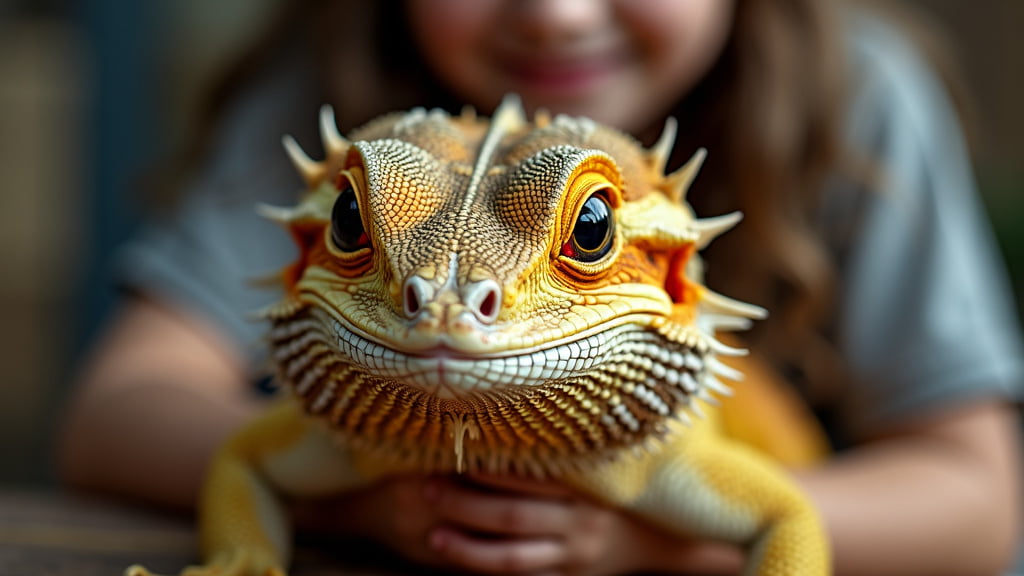Handling Bearded Dragons with Children: A Guide for Families
Bearded Dragons are wonderful pets that can bring immense joy to any household, including those with children. Their gentle demeanour and curious nature make them an excellent choice for families. However, handling these reptiles, especially with children involved, requires specific care and attention to ensure the safety and wellbeing of both the pet and the little ones.
Introduction
Are you considering a Bearded Dragon as a pet for your family? Or perhaps you already have one and want to know how to handle it safely and effectively with your children? You’ve come to the right place. This comprehensive guide will walk you through the essentials of handling Bearded Dragons with children, ensuring a harmonious and happy experience for everyone involved.
Why Bearded Dragons Make Great Pets for Children
When it comes to family pets, Bearded Dragons are a fantastic choice. Here’s why:
Gentle Nature
Bearded Dragons are known for their calm and gentle nature. Unlike some other reptiles, they are generally more docile and rarely show aggression when handled properly.
Low Maintenance
While they do have specific care requirements, Bearded Dragons are relatively low maintenance compared to other exotics. Proper tank setup, diet, and regular health checks are more than enough to keep them happy.
Educational Value
Having a Bearded Dragon can be an enriching learning experience for children. They can learn about responsibility, biology, and the importance of taking care of another living creature.
Preparing for Handling
Before you start handling your Bearded Dragon, preparing both the pet and the children is crucial.
Educating Children
Children should understand that while Bearded Dragons are pets, they are not toys. Teach them to be gentle and always supervise interactions.
Key Points to Cover:
- Hand Hygiene: Always wash hands before and after handling.
- Handling Time: Restrict handling to short periods to avoid stressing the dragon.
- Gentle Touch: Show them how to support the dragon’s body, keeping it close to the floor to prevent falls.
Setting Up the Environment
Make sure the area where you plan to handle the Bearded Dragon is safe and secure.
Considerations:
- Free of Hazards: Ensure there are no harmful objects or areas the dragon can escape into.
- Calm Atmosphere: A quiet room reduces stress for both the dragon and the children.
- Appropriate Temperature: Bearded Dragons are ectothermic, so make sure the room is not too cold.
Socialising Your Dragon
If your Bearded Dragon is new to handling, gradually introduce it to being held. Start with short, gentle handling sessions and increase the duration as it becomes more comfortable.
Handling Techniques for Children
Ensuring proper handling techniques will make the experience enjoyable and safe for both your child and Bearded Dragon.
Initial Approach
Teach children to approach the Bearded Dragon slowly and from the front. Sudden movements or approaching from above can startle the reptile.
Supporting the Dragon
Show children how to properly support the Bearded Dragon by placing one hand under its chest and the other under its tail. This support prevents any risk of dropping and provides comfort to the dragon.
Reading Body Language
Bearded Dragons communicate through body language. If your dragon is puffing up its beard, hissing, or trying to flee, it’s best to give it some space and try again later.
Health and Safety Considerations
Whilst Bearded Dragons are sturdy pets, it’s vital to consider their health and safety, particularly when children are handling them.
Regular Health Checks
Monitor your Bearded Dragon regularly for any signs of stress or illness. Consistent health checks can help you catch problems early. If you notice anything worrying, always consult a vet experienced with reptiles.
Hygiene Practices
Bearded Dragons can carry salmonella. Teaching children to wash their hands thoroughly after handling the dragon can prevent any potential health risks.
Hand Washing Tips:
- Use soap and water.
- Scrub for at least 20 seconds.
Risk Minimisation
Make sure the children understand not to put their hands in their mouths or near their faces during or after handling the Bearded Dragon until they have washed their hands.
Conclusion
Handling Bearded Dragons with children can be a delightful experience that enriches your family life. With proper education, preparation, and care, these gentle reptiles can thrive and form a close bond with their human companions. Remember, the key to successful handling is understanding and respecting both the pet’s and the children’s needs.
If you found this guide helpful, explore our Comprehensive Care Guide for Bearded Dragons.
Meta Description
Learn how to safely and effectively handle Bearded Dragons with children. This comprehensive guide offers tips, techniques, and safety considerations for a delightful experience with your reptile pet.
Embarking on a journey with a Bearded Dragon in the family can be immensely rewarding. With the insights I’ve shared from personal experience, along with general best practices, you’re well-equipped to offer a loving and safe environment for your dragon and children alike. Happy handling!

